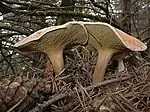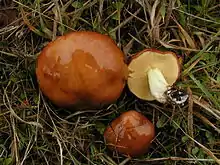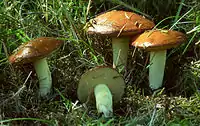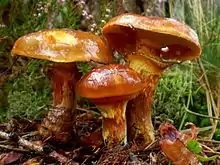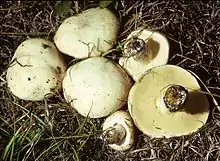| Suillus | |
|---|---|
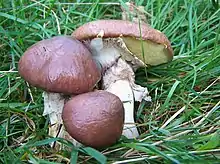 | |
| Suillus luteus | |
| Scientific classification | |
| Domain: | Eukaryota |
| Kingdom: | Fungi |
| Division: | Basidiomycota |
| Class: | Agaricomycetes |
| Order: | Boletales |
| Family: | Suillaceae |
| Genus: | Suillus Gray (1821) |
| Type species | |
| Suillus luteus (L.) Roussel (1821) | |
| Synonyms[1] | |
| |
Suillus is a genus of basidiomycete fungi in the family Suillaceae and order Boletales. Species in the genus are associated with trees in the pine family (Pinaceae), and are mostly distributed in temperate locations in the Northern Hemisphere, although some species have been introduced to the Southern Hemisphere.[2]
Taxonomy
The genus Suillus was first defined by Pier Antonio Micheli in his 1729 work Nova plantarum genera, however it is not valid as it predates the 1753 start of Linnean taxonomy.[3] Fries sanctioned the use by British botanist Samuel Frederick Gray in the first volume of his 1821 work A Natural Arrangement of British Plants. Setting Suillus luteus as the type species, he described the genus as those mushrooms with a centrally placed stipe, a distinct ring, a circular cap, and tubes that are stuck together.[4]
They have been commonly called "slippery jacks" because the cap of the fruit body is sometimes slimy. The genus name is derived from the Latin sus, meaning "pig". Before 1997, the genus Suillus was considered part of the family Boletaceae.
The genus also contains what were known as the larch boletes, several species that were described in the genus Fuscoboletinus. These grow in association with larch or tamarack (Larix ssp.). Molecular analysis has shown them to not be a monophyletic group and to be mixed in with the Suillus species.[lower-alpha 1]
Description
Structures of the fungi in this genus in common with other members of the order Boletales include the presence of a cylindrical stipe, cap, soft flesh and tubular hymenium. Specific characteristics common to most species in Suillus are the cap cuticle which is often slimy and sticky when moist, the presence of darkly staining, clustered, sterile cells called cystidia that give the tube mouths or the stipe surface a speckled or glandular appearance, spores that are usually cinnamon brown or chocolate brown in mass, and obligate mycorrhizal relationships primarily with members of the Pinaceae, especially with members of the genera Pinus, Larix and Pseudotsuga.
Intra-genus variation may be demonstrated by differences in colour and ornamentation of the cap cuticle, flesh, pores and stipe, the presence of a partial veil in immature forms and annuli thereafter, pore shape and distribution, as well as habitat. The cap cuticle is dark brown in S. brevipes, and yellow in S. grevillei. S. granulatus has a smooth cap cuticle, while that of S. lakei is finely scaly. The pores are bright yellow in S. collinitus, cinnamon in S. variegatus and grey in S. viscidus; in shape they are round in S. luteus and angular in S. bovinus. The flesh is white to yellow in S. luteus, while it is pallid in S. variegatus with a tendency to turn blue when exposed to air. Young S. luteus and S. grevillei bear partial veils whose remnants remain as annuli hanging from the stipe; in S. granulatus the stipe is bare. S. viscidus and S. grevillei occur under larch (Larix) only, while S. sibiricus is restricted to a few species of 5-needled pine (Pinus).
Habitat and distribution
Species of Suillus are found all over the Northern Hemisphere where members of the tree family Pinaceae can be found. Although a few species are distributed in tropical regions (usually mountainous areas), most are limited to temperate areas. Some species have been introduced adventitiously with pine trees in pine plantations outside the natural area of Pinaceae.[6]
Some Suillus species have entered regional red lists as endangered or vulnerable. Seven European countries have listed S. sibiricus.[7] Individual countries have also listed other species, including S. flavidus, S. tridentinus, S. collinitus, S. plorans and S. lakei.[8]
Uses
Some Suillus species are edible and are highly esteemed, particularly in Slavic countries, where they are generally referred to as butter mushrooms (маслята). They are generally picked as buttons when the flesh is still firm. In some species, the slimy cap coat acts as a purgative when consumed and should be removed before cooking. Species of Suillus have been associated with the term "bolete", given to members of other genera bearing pores, most notably Boletus.
Some species can be used to make mushroom dyes, like S. americanus, S. cothurnatus, S. granulatus,[9] and S. luteus.[10]
Species
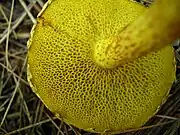
As of May 2016, Index Fungorum lists 98 valid species of Suillus:[11]
- S. abietinus
- S. acerbus
- S. acidus
- S. albidipes
- S. albivelatus (edible)[12]
- S. alboflocculosus
- S. alkaliaurantians
- S. amabilis
- S. americanus – chicken-fat suillus
- S. anomalus
- S. appendiculatus
- S. bellinii
- S. borealis
- S. boudieri
- S. bovinoides
- S. bovinus – Jersey cow mushroom
- S. bresadolae
- S. brevipes – short-stalked suillus
- S. brunnescens
- S. caerulescens
- S. californicus
- S. cavipes
- S. cavipoides[13] – China
- S. cembrae
- S. chiapasensis
- S. collarius
- S. collinitus
- S. cothurnatus
- S. decipiens
- S. flavidus (also known as S. umbonatus)[14]
- S. flavogranulatus
- S. flavoluteus
- S. flavus
- S. furfuraceus
- S. fuscotomentosus
- S. glandulosipes
- S. gloeous – China
- S. granulatus – dotted-stalk suillus
- S. grevillei – larch suillus, larch bolete
- S. grisellus
- S. guzmanii
- S. helenae
- S. hirtellus
- S. hololeucus
- Suillus holomaculatus – Mauritius
- S. intermedius
- S. jacuticus
- S. kaibabensis
- S. kunmingensis[13] – China
- S. lakei – western painted suillus
- S. lapponicus – Finland
- S. lithocarpi-sequoiae
- S. lutescens
- S. luteus – slippery Jack (many Suillus species are called by this common name)
- S. marginielevatus – Pakistan[15]
- S. mediterraneensis
- S. megaporinus
- S. monticola
- S. neoalbidipes
- S. obscurus – Greece
- S. occidentalis
- S. ochraceoroseus
- S. pallidiceps
- S. pinorigidus
- S. placidus – white suillus
- S. plorans
- S. ponderosus
- S. pseudoalbivelatus – Dominican Republic
- S. pseudobrevipes
- S. punctipes
- S. pungens – pungent suillus
- S. quiescens[16] – USA
- S. reticulatus
- S. riparius
- S. roseoporus
- S. roseovelatus – Greece
- S. ruber
- S. rubricontextus – China
- S. rubropunctatus
- S. salmonicolor
- S. serotinus
- S. sibiricus
- S. spraguei – painted suillus
- S. subacerbus – New Zealand[17]
- S. subalpinus
- S. subaureus
- S. subluteus – slippery Jill
- S. subolivaceus
- S. subreticulatus – China
- S. subvariegatus
- S. tomentosus – tomentose suillus
- S. triacicularis[18] – India
- S. tridentinus
- S. variegatus – velvet bolete
- S. viscidus – sticky bolete
- S. volcanalis
- S. wasatchicus
- S. weaverae
See also
Notes
- ↑ these were:
- Fuscoboletinus aeruginascens - Grayish larch bolete (edible)[5]
- Fuscoboletinus glandulosus
- Fuscoboletinus grisellus
- Fuscoboletinus ochraceoroseus - Rosy larch bolete
- Fuscoboletinus paluster
- Fuscoboletinus serotinus
- Fuscoboletinus sinuspaulianus
- Fuscoboletinus spectabilis - Bog bolete
- Fuscoboletinus weaverae
References
- ↑ "Suillus Gray 1821". MycoBank. International Mycological Association. Retrieved 28 October 2012.
- ↑ Kirk PM, Cannon PF, Minter DW, Stalpers JA (2008). Dictionary of the Fungi (10th ed.). Wallingford, UK: CAB International. p. 672. ISBN 978-0-85199-826-8.
- ↑ Hans V. Hansen & Ole Seberg (1984). "On the Typification of Suillus (Boletaceae, Basidiomycotina)". Taxon. 33 (4): 711–. doi:10.2307/1220791. JSTOR 1220791.
- ↑ Gray SF. (1821). A Natural Arrangement of British Plants. Vol. 1. London, UK: Baldwin, Cradock, and Joy. p. 646.
- ↑ Phillips, Roger (2010). Mushrooms and Other Fungi of North America. Buffalo, NY: Firefly Books. p. 294. ISBN 978-1-55407-651-2.
- ↑ Singer R. (1986). The Agaricales in Modern Taxonomy (4th ed.). Königstein im Taunus, Germany: Koeltz Scientific Books. pp. 752–7. ISBN 3-87429-254-1.
- ↑ Dahlberg A, Croneborg H (2006). The 33 Threatened Fungi in Europe. Council of Europe. p. 113. ISBN 978-92-871-5928-1.
- ↑ "Red Lists". European Council for the Conservation of Fungi. Retrieved 29 November 2009.
- ↑ Bessette A, Bessette AR (2001). The Rainbow Beneath my Feet: A Mushroom Dyer's Field Guide. Syracuse, New York: Syracuse University Press. pp. 49–52. ISBN 0-8156-0680-X.
- ↑ Pazarioglu NK, Akkaya A, Sariisik AM, Erkan G, Kumbasar EPA (2011). "Dyeing of wool fibers with natural fungal dye from Suillus luteus". Asian Journal of Chemistry. 23 (6): 2600–4. ISSN 0970-7077.
- ↑ "Species Fungorum (version January 2016). In: Species 2000 & ITIS Catalogue of Life". Archived from the original on 25 February 2018. Retrieved 18 May 2016.
- ↑ Phillips, Roger (2010). Mushrooms and Other Fungi of North America. Buffalo, NY: Firefly Books. p. 292. ISBN 978-1-55407-651-2.
- 1 2 Wang Q-B, Yao Y-J (2004). "Revision and nomenclature of several boletes in China". Mycotaxon. 89 (2): 341–8.
- ↑ Miller Jr., Orson K.; Miller, Hope H. (2006). North American Mushrooms: A Field Guide to Edible and Inedible Fungi. Guilford, CN: FalconGuide. p. 364. ISBN 978-0-7627-3109-1.
- ↑ Sarwar S, Saba M, Khalid AN, Dentinger BM (2015). "Suillus marginielevatus, a new species and S. triacicularis, a new record from Western Himalaya, Pakistan". Phytotaxa. 203 (2): 169–77. doi:10.11646/phytotaxa.203.2.6.
- ↑ Bruns TD, Grusiba LC, Trappe JM, Kerekes JF, Vellinga EC (2010). "Suillus quiescens, a new species commonly found in the spore bank in California and Oregon". Mycologia. 102 (2): 438–46. doi:10.3852/09-149. PMID 20361510. S2CID 16220685.
- ↑ McNabb RFR. (1968). "The Boletaceae of New Zealand". New Zealand Journal of Botany. 6 (2): 137–76 (see p. 166). doi:10.1080/0028825X.1968.10429056.

- ↑ Verma B, Reddy S (2014). "Suillus triacicularis sp. nov., a new species associated with Pinus roxburghii from northwestern Himalayas, India". Phytotaxa. 162 (3): 157–64. doi:10.11646/phytotaxa.162.3.4.
- Bessette AE, Roody WC & Bessette AR. (2000). North American boletes: A color guide to the fleshy pored mushrooms. China: Syracuse UP. 399 pp.
- Bruns TD, Palmer JD (1989). "Evolution of mushroom mitochondrial DNA: Suillus and related genera" (PDF). Journal of Molecular Evolution. 28 (4): 349–362. Bibcode:1989JMolE..28..349B. doi:10.1007/BF02103431. hdl:2027.42/48043. PMID 2499689. S2CID 17513349.
- Smith AH, Smith HV & Weber NS. (1981). How to know the non-gilled mushrooms. Dubuque, Iowa: Wm. C. Brown. 324 pp.
- National Audubon Society Field Guide to North American Mushrooms, Knopf, 1981.
